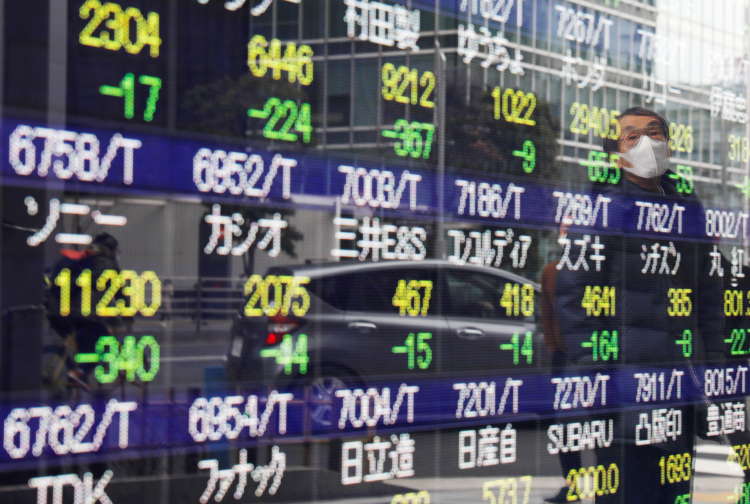Trading
Asian stocks bounce off two-month low as bonds, China markets steady

By Hideyuki Sano and Matt Scuffham
TOKYO/NEW YORK (Reuters) – Asian stocks bounced back from a two-month low on Wednesday after global bond yields eased following a well-received U.S. debt auction and as Chinese shares found a footing after recent steep falls on policy tightening worries.
A recent sell-off in global bonds has unsettled markets generally as concerns central banks could begin tightening the monetary spigot pushed yields higher, sparking worries higher borrowing costs could derail a fragile global economic recovery.
Japan’s Nikkei was little changed while MSCI’s ex-Japan Asia-Pacific shares index rose 0.2%, a day after it hit a two-month low. The CSI300 index of mainland China’s A-shares rose 0.4%.
Despite this, European and U.S. shares eased slightly as investors remained nervous about a bond bear run ahead of key inflation data and bond auctions in the United States.
Euro Stoxx 50 futures fell 0.3%, while Britain’s FTSE futures traded 0.7% lower.
Gains in Asian stocks came after Chinese shares had fallen to their lowest levels since mid-December the previous day on the prospect of tighter policy and a slowing economic recovery.
“Markets are giving full attention to bonds. As earnings are not growing that fast right now, the lofty stock prices we have now will become unsustainable if bond yields rise further and undermine their valuation,” said Hiroshi Watanabe, senior economist at Sony Financial Holdings.
The yield on benchmark 10-year notes slipped to 1.540%, having peaked at 1.626% on Friday, after Tuesday’s auction of $58 billion in U.S. 3-year notes was well received.
Yet, many market investors remained on edge, with the next tests of investor appetite for government debt due later this week in the form of 10-year and 30-year auctions.
“Although the bond market has steadied a bit, pressures will remain,” said Naokazu Koshimizu, senior rates strategist at Nomura Securities.
“It has priced in future normalisation of the Fed’s monetary policy, the Fed’s policy becoming eventually neutral. But it has not yet priced in the chance of its policy becoming tighter.”
Some investors see a real risk of an overheated U.S. economy and higher inflation on the back of planned spending by U.S. President Joe Biden’s administration, including a $1.9 trillion stimulus and an even bigger initiative on infrastructure.
U.S. consumer price data due at 1330 GMT is expected to show a slight acceleration in the overall inflation in February, with analysts expecting further gains in coming months due to base effects from a severe economic downturn in early 2020.
The speedier rollout of COVID-19 vaccines in some countries and the planned U.S. stimulus package helped underpin a brighter global economic outlook, the Organisation for Economic Cooperation and Development said, as it raised its 2021 growth forecast.
Some investors worry loose monetary policy could unleash inflation, though Federal Reserve Chair Jerome Powell has so far pledged to keep low interest rates and maintain its monthly bond purchase of $120 billion.
In foreign exchange markets, the dollar was supported by expectations of faster U.S. economic recovery.
The euro eased 0.25% to $1.1871, not far from Tuesday’s 3 1/2-month low of $1.18355. The yen changed hands at 108.85 per dollar, having hit a nine-month low of 109.235 set the previous day.
The Australian dollar shed 0.6% to $0.7672 after the country’s top central banker rebuffed market chatter about early rate increases. [AUD/]
Oil prices fell as concerns over a supply disruption in Saudi Arabia eased.
U.S. crude futures slipped 0.9% to $63.44 per barrel, away from a near 2 1/2-year high of $67.98 touched on Monday.
Brent crude futures dropped 1.1% to $66.78 per barrel.
(Reporting by Hideyuki Sano in Tokyo and Matt Scuffham in New York; Editing by Sam Holmes, Richard Pullin and Ana Nicolaci da Costa)

-
Investing2 days ago
7 Tips to Start Your Retirement Planning
-
Trading3 days ago
FBS Financial Market Analysts Forecast Gold Prices to Rise to $2,800
-
Finance3 days ago
Bandit Network’s Points SDK and Brave Ads Power Astar zkEVM’s Quest Platform “Yoki Origins”
-
Banking3 days ago
The Role of Geopolitical Tensions in Shaping Digital Banking’s Future in Emerging Markets







